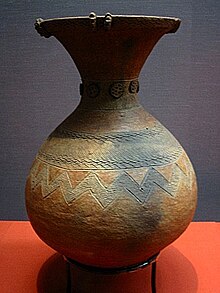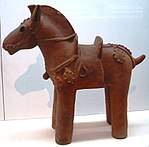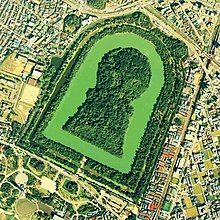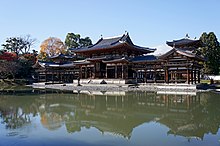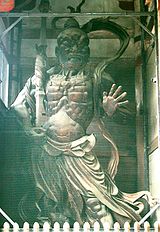Japanese art
The Japanese art covers a wide range of styles, media and forms of expression. The art of swordsmithing, pottery, sculptures made of wood and bronze, ink paintings on silk and paper, calligraphy, weaving art, lacquer work and color prints achieved international fame . The oldest art is ceramics, which goes back to the 10th millennium BC.
Japanese art is based on the special principles of Japanese aesthetics . In contrast to European art, which values the decorative “work of art”, Japanese art has always been and is also practical art: a tea bowl only becomes valuable when the years of use have given it the necessary patina . The transience of art is also valued: in a country so frequently ravaged by natural disasters, almost every temple has been rebuilt many times, and it is the preservation of the craftsmanship, not the building, that keeps tradition alive. This philosophy becomes even clearer in the artfully prepared Japanese dishes that do not survive the meal.
history
Historically, the development of art has seen strong changes, from periods in which outside influences were enthusiastically received and led to a multitude of new ideas, syntheses and styles, to phases of isolation and seclusion in which the existing was revised and brought to perfection has been. Influences from outside, whether from China , Korea , India , from the 16th century onwards Europe and in modern times the USA, were absorbed, imitated and assimilated. They influenced Japanese aesthetic ideals and were influenced by them. The introduction of Buddhism in the 7th and 8th centuries gave a big boost, affecting temples, sculpture and poetry, among other things. In the 9th century, after the departure from China, the secular arts became more important. Art flourished for the first time at the court of the Heian period . With the rise of the warrior nobility under the influence of Zen Buddhism from the 13th century onwards, a new aesthetic ideal arose that was based on simplicity, harmony and transience.
In the 15th and 16th centuries the country got into political unrest. Powerful daimyo fought for supremacy in the country, and at the same time new ideas came into the country with the Europeans, above all Christianity . It was a time when a lot of new things were created, but also a lot of old things were destroyed. Only with the victory of the Tokugawa did calm return in the Edo period to the point of complete isolation of the country. The flourishing cities created their own art, especially the kabuki theater and ukiyo-e (woodblock prints). At first it was in competition with the art of the samurai, but in the 18th and 19th centuries both directions merged more and more.
Only with the opening of Japan and the Meiji Restoration did a new wave of upheaval come. Traditional Japanese art now faced competition from European works. This resulted in styles that completely turned away from the old and imitated European art, as well as those that wanted to preserve tradition and adapt to modern times. At the same time in Europe in the early 20th century, interest in Japanese art arose in a style called Japonism .
Jōmon culture
The so-called Jōmon culture, established by the first settlers in Japan, existed during the Jōmon period , approximately from 11,000 BC. Until 300 BC The previous Paleolithic culture shows no artistic processing of tools or the like. on. The earliest forms indicative of artistic activity in Japan are found in Neolithic ceramics. The vessels made were intended for practical use as the people of that time were hunters and fishermen. The most frequently used decorations were mat or string imprints (Japanese Jōmon ) on vessels. The ceramic was therefore decorated with simple line patterns that were imprinted with the fingernail or with the help of mats. They are very similar to the Korean comb pottery , while tool finds show similarities with finds from Siberia , Mongolia or northern China. Since the middle Jōmon period, more figures were found that probably served generally as protective figures or to heal the sick. Some figures point to a fertility rite, which shows that people have now farmed in addition to hunting. Starting from the settling down, flat, lightly fired clay bowls spread out, which were completely covered with line patterns. Towards the end of the Jōmon period, the vessels became smaller and sometimes polished black or painted red. The figures, called Dogū , were z. Sometimes very abstract and now depicted people as well as animals. They were only designed for the front view, so that they were rather flat when viewed from the side.
Yayoi culture
The Yayoi culture emerged from the subsequent wave of immigrants. It was named after a suburb in Tokyo where the remains of Yayoi settlements were first found. The culture existed from 300 BC. BC to approx. 300 AD, during the Yayoi period named after her . During this time the transition to the metal age took place . The people of the Yayoi period came to Japan from central and northern China via South Korea . They brought the knowledge of rice cultivation with them, so the people settled on the rivers in the north of Kyūshū to grow rice in favorable regions. From there they spread over the west of Honshū to the so-called Kinai district (in the region of Nara and Osaka ). Village complexes have been discovered here, showing that people lived in houses on stilts covered with plant material. As a result of ongoing relationships with the mainland, there were not only improved stone and wood tools based on the Korean model but also bronze or iron tools . These were first copied in clay and stone, but soon afterwards people were able to melt metal themselves. So are z. B. stone molds have been found that prove this. Weapons, shields and tools, but also bronze bells, dotakus , were cast since the middle Yayoi period . The bells were found mainly in the west of Honshū and on Shikoku . Similar bells existed in China, where they were struck during rituals. The bottom of the Japanese bells were elliptical and flat and their surface was divided into fields with fine internal drawings by sawtooth or network strips. Animals or plants were depicted in relief, but bells with house models and work scenes were also found. Since the Yayoi period there have also been bronze mirrors, i.e. bare metal disks that were heavily decorated on one side. They also came to the island from China and were strongly based on their role models. The decorations were initially more in the form of geometric ornaments, later animals and deities were also scratched. These mirrors have been used as symbols of power since the 8th century. Jomon ceramics were replaced by Yayoi ceramics, with continental forms serving as models. This is how jugs with wide openings or narrow necks, lidded vessels and bowls on high feet were created. In contrast to the often heavily overloaded Jomon ceramics, this ceramic was almost without a pattern or only had sparsely carved ornaments. The more the Yayoi culture spread, the more the forms changed. In the east of the country it merged very strongly with the Jomon culture. The small figures of the earlier culture disappeared, instead jugs decorated with faces were found in graves. Scientists suspect urns in them that were adopted from the Korean cult of the dead.
Kofun time
The Kofun culture existed between the 3rd and 7th centuries of our time. With the help of the improved agriculture through the new metal implements, a tribal nobility developed in the Kofun culture. Individual tribes then joined together to form tribal associations, from which the central Japanese Yamato gained control in the 4th century . A constant exchange of craftsmen was promoted with Korea, which culminated in the 405 posting of the scribe Wani . He officially introduced the Chinese script in Japan. In addition, the first Buddhist ideas came to the islands. Funeral customs also changed. After the tribal system was established, mounds were built over the graves of chiefs. These established the "time of the old burial mounds ", called tumuli or Kofun in Japanese (250–552 AD). The mounds were either round, rectangular, or pyramidal in shape and had a circular dome. The bronze mirrors of the Yayoi period served as grave supplements, but also bracelets made of shells, devices made of wood and devices made of red clay, the so-called Haji ceramics , which followed the ceramics of the Yayoi period.
In the middle of the Kofun period (5th century), the Yamato state had developed warlike. There were now iron swords and armor, which were occasionally decorated with gold and silver. The graves assumed enormous dimensions, they could be up to 400 m long and 30 m high. The keyhole tombs that were surrounded by moats prevailed , such as the Daisenryō-Kofun of Emperor Nintoku in Sakai , Osaka Prefecture . The use of the haniwa also increased. These were clay pipes that formed a kind of wall around a grave. They were supplemented with essays depicting animals (e.g. horses or water birds). In the middle of the 5th century a whole funeral escort, consisting of peasants, priests, dancers, warriors, etc., made of clay for high-ranking people, was added. These figures, some as tall as a man, were made of red clay and were sometimes two-colored and provided with patterns. They often give a historically accurate picture of the clothing, jewelry and armament of people. Hundreds of these figures could stand at a grave, but they are not as finely worked out as the terracotta army of the Chinese Emperor Qin Shihuangdi , as they were basically made of clay pipes. They are perhaps the least continentally influenced art of the Kofun culture. In northern Kyushu, other forms of burial became established. There, graves with wall paintings and underground passages were common.
Asuka period (552-710)
During the Asuka period , Japan was transformed into a unitary state based on the continental Chinese model. The central settlement of the state, after which this period was named, was on the Yamato plain. At the beginning of the 6th century Japan became increasingly aware of Buddhism , which was taken up by the ruling class alongside the prevailing Shinto . In the course of this there was an exchange of Chinese monks and Japanese Buddhists. So the relations between island and continent continued to be cultivated. The imperial nephew and Prince Regent Shōtoku raised Buddhism to the state religion in 594 during the reign of Empress Suiko . Thanks to Shōtoku's efforts, aristocrats began to finance the construction of temples. Numerous Buddhist buildings were built, so that at the end of Shōtoku's tenure (622 AD) there were 46 temples, shrines, pagodas and monasteries (vihara) around Nara alone , in which over 1200 monks and nuns lived. The art of the Asuka period is all about religious relics, buildings and paintings.
The wooden architecture of the first temples, for which Hōryū-ji near Nara, founded in 607, still bears witness, reflects the architecture of China in the structure and style. The temple was built in the typical post construction with retracted filling walls and a heavy tiled roof. The building was complemented by a multi-storey pagoda. The main hall kondo (also hondo ) houses old cult images. The entire temple area is bordered by a walkway with a gate. Numerous artists of Korean and Chinese origin came to Japan to design these Buddhist buildings, and their craftsmanship was adopted by the Japanese. The bronze sculptures from the early 7th century were sometimes very large and reflect the style of the Northern Wei Dynasty , a Chinese style that was a century older. Bronze works of art still preserved from the period are the Shaka trinity of Hōryū-ji made in 623 and the 606 cast Shaka of Asuka-dera . They are similar to the style of the cave temples in Lung-men . Both works were made by the Buddha image master (busshi) Tori, who had learned his art from Chinese teachers and was one of the first Japanese masters in bronze casting.
In addition to the bronze figures, there were also wooden sculptures in the Asuka period, but only a few have survived. The figures of the Kudara Kannon and the Yumedono Kannon in Hōryū-ji , as well as the Bodhisattva in hankashinyui pose (dt. Thoughtful posture) in Chigu-ji to Nara show influences from southern China, the northern Qi and northern Zhou dynasties as well as Korea .
Nara period (710-794)

The Nara period was named after Japan's first permanent rulership, Nara . As in previous centuries, the Chinese influence remained strong, and the structure of Nara is modeled on the Chinese metropolis Chang-an . In addition, the Nara period, like the Asuka period before, was dominated by the construction of temples and the associated Buddhist relics, based on the model of the art of the Sui or Tang dynasty ruling in China at the time . The great temples became centers of religious art. Built between 745 and 752, the Tōdai-ji was established as the headquarters of a network of temples in each province .

The production of the paintings and figures was taken over by Buddhist sculpture workshops ( zōbutsujo ) of the temples, which were subordinate to the temple building offices of the government and were organized in guilds. Sculptures were made from dry varnish ( kanshitsu ), clay or bronze. Above all, the Tang art of the Chinese sculptors of the 8th century, who had made the sculptures for the Tōshōdai-ji temple under the direction of priest Chien-chen (Japanese Ganjin) , shaped the Japanese style. A 16-meter-high bronze Roshana Buddha statue from the year 752, which stands in the prayer hall of Tōdai-ji, still bears witness to the influence of Buddhism at that time. Not much is known about painting in the 8th century as a fire in 1949 destroyed the frescoes in the Hōryū-ji Temple . It is known, however, that these frescoes, like the image of the goddess Kichijōten in Yakushiji, were also based on the Tang style. Other paintings, such as the cross scrolls of the E'ingakyō Temple, were more based on the Chinese model of the 6th century. This clearly shows the time delay in adopting the styles. Secular and political picture cycles that were not intended for the temples were created for the court. Responsible for this was the Office for Painting ( edakumi tsukasa ), which had been under the Ministry of the Interior since 701.
A unique cultural and historical source is the collection of almost 10,000 objects, which ended up in the specially built Shōsōin des Tōdai-ji treasury in 756 . These are mostly Chinese weapons, furniture, textiles, ceramics and small art made of metal, wood and ivory , which the widow of the late Emperor Shōmu (724-748) donated to the temple. The few items made in Japan are entirely influenced by Chinese tradition.
Even in the Nara period, the Chinese script was still practiced, with the help of which Buddhist texts were copied and read. The cultural meaning of the Chinese script is not limited to religion. So in the 8th century two important writings, the Nihonshoki ("Chronicles of Japan") and the Kojiki ("Myths and reports on earlier events") were written. The Man'yōshū , also written down in the 8th century , the "collection of a myriad of leaves", is an anthology of the oldest poems in Japan.
Heian period (794–1185)

In 794 the capital of Japan was officially moved to Heian-kyō , today's Kyoto . The years 794 to 1185 are therefore known as the Heian period . The Heian period is further divided into early and late Heian periods, with the late Heian period also being referred to as the Fujiwara period. The decisive date is the year 894, when the diplomatic missions to China were canceled.
Inspired by the power and wealth of Buddhism in Nara, the monk Kūkai , better known by his posthumous title Kōbō-Daishi, traveled to China to study Shingon , a form of Vajrayana Buddhism that he brought to Japan in 806. At the center of Shingon are the mandala , diagrams of the spiritual universe, a concept that also had an impact on temple architecture. The architectural concept of the stupa from Indian architecture was also adopted, but in the Chinese style of the pagoda .
The Shingon School temples were built in the mountains, away from the imperial court and the hustle and bustle of the capital. The uneven and rocky landscape of these places led the temple architects to develop a new, independent style. Cypress bark roofs replaced the burned shingles, wooden planks replaced the earthen floors, and a separate prayer area for the lay people was set up in front of the main shrine.

The temple that best reflects the style of the Shingon temple of the early Heian period is the Muroji from the early 9th century, hidden in a cypress grove on a mountain south of Nara. A wooden image of Siddhartha Gautama , the historical Buddha, which also dates from the 9th century, is venerated in an outbuilding of Muroji . It is a typical representative of the sculpture from this time, with its massive body and the clearly elaborated folds of the clothes in the hompa-shiki ( curved wave style ) as well as its serious, remote facial expression.
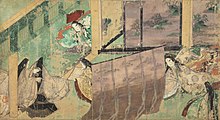
The following Fujiwara period is named after the dominant family at the imperial court in Heian-kyō . Classical Chinese culture had meanwhile established itself in Japan, and an independent Japanese art and aesthetic developed from this legacy. In the field of poetry, the waka was created as an alternative to poetry in the Chinese language ( kanshi ). In literature, Sei Shōnagon with the pillow book and Murasaki Shikibu with the story of Prince Genji created classics that still offer a vivid picture of the flourishing court life of that time.
Emaki , a form of illustrated stories, developed at the same time as the court literature . This is drawn, painted or printed on a hand roller. It is influenced by cultural elements and scrolls that came to Japan along with Buddhism in the 6th century.
In the field of religion, Amitabha Buddhism , the doctrine of the Pure Land , promised simple salvation through belief in Amitabha , or Amida in Japanese . This is reflected in architecture in the shape of the Amida Hall, which combines the secular with the religious and which houses one or more Buddha statues in a building similar to the country residence of a nobleman. An example of such an Amida Hall is the Phoenix Hall of Byōdō-in , a temple in Uji, southeast of Kyoto, built in 1053 .
Kamakura period (1185-1333)
In 1180 the Gempei War broke out between the two most powerful families, the Taira and the Minamoto , from which the Minamoto emerged victorious. The importance of the court in Heian-kyō faded, and the small fishing village of Kamakura on the Kantō plain became the new center of power in Japan. Power shifted to the bushi , the warrior nobility. At the same time, Buddhist reformers roamed the country, simplifying the former noble religion and preaching to the common people. Both of these ensured that the art was now promoted by men with more down-to-earth interests, which led to a new realism. On the other hand, conservative forces in the nobility and the priesthood tried a countermovement and a resurrection of the classical arts.
The sculptors of the Kei school , especially Unkei , created a new, more realistic style of sculpture. The two Niō guardian sculptures in the southern main gate of the Tōdai-ji in Nara from 1203 particularly illustrate Unkei's dynamic, supra-realistic style. The figures, around eight meters high, were carved out of several blocks over a period of three months, which suggests an artist workshop in which a large number of artists work under the guidance of a master. Unkei's multi-colored wooden sculptures by two Indian sages ( Kōfuku-ji , Nara), Muchaku and Seshin, the mythical founders of the Hossō school, are among the most accomplished works of the period. The way they were created by Unkei, they are extraordinarily individual and lifelike figures.
Muromachi period (1338–1573)
During the Muromachi period (1338-1573) laid the Shoguns family Ashikaga the throne of the government back to Kyoto. This ended the popularization trend from the Kamakura period, and art regained a courtly and aristocratic character. The Chan -Buddhismus was introduced a second time in Japan and practiced as a Zen affected mainly the Samurai big impact.
Trade with China, ruled by the Ming Dynasty at that time , was intensified again, including from Zen temples, and so many Chinese paintings and other art objects came to Japan. Under the influence of Ming art, the subjects of painting changed, but so did the colors: the bright colors of the Yamato-e fell out of fashion and were replaced by the black-and-white ink drawings of the Sumi-e .
A representative example of painting from the early Muromachi period is the depiction of the monk Kensu (Chinese: Hsien-tzu) at the moment of his enlightenment by the priest-painter Kao . The style of the drawing is characterized by quick brushstrokes and a minimum of details. The drawing "Angling the catfish with a pumpkin bottle" ( Josetsu , around 1413, Taizō-in , Myōshin-ji , Kyōto) represents a turning point in painting from the Muromachi period. Originally created for a screen, it was attached to a scroll and provided with contemporary notices. One of these notes describes the work as "in the new style". In the foreground you can see a man with a pumpkin bottle standing on a river bank, looking at a catfish. The center of the image is filled with fog and there are mountains in the distance in the background. It is believed that this "new style" refers to the representation of the depth of space in the image plane.
Shūbun and Sesshū are considered to be the most important representatives of Muromachi art . Shubun, a monk at the Shokoku -ji temple in Kyoto , created the painting “Reading in a Bamboo Grove” (1446), a realistic landscape with a deep spatial impression. Sesshū, unlike most of his contemporaries, traveled to China and studied contemporary Chinese painting at the source. The "Long Scroll", which depicts a coherent landscape over the course of the four seasons, is considered to be the highlight of his work.
Azuchi Momoyama period (1573-1603)
During the Azuchi Momoyama period (1573-1603), the three unifiers Oda Nobunaga , Toyotomi Hideyoshi and Tokugawa Ieyasu succeeded in uniting the country under the hand of central authority after a hundred years of civil war. They were very rigorous in doing so. The buildings and art treasures of Buddhist temples also went up in flames, as these, equipped with their own armies, represented a significant power factor that had to be eliminated.
Meanwhile the European trading and colonial powers Spain, Portugal and the Netherlands put out feelers to Japan. During this " epoch of the Namban trade " ( namban , "southern barbarians", the Europeans are called by the Japanese), western arms, armaments and shipbuilding came to Japan. Jesuit missionaries succeeded in converting Japanese feudal princes ( daimyo ) to Christianity. For a short time there was therefore also Christian art in the Japanese style.
Painting also flourished again, the most important style of this time being the Kanō school . The monumental landscapes on sliding doors ( Fusuma ), as developed by Kanō Eitoku , were formative . Probably the most beautiful surviving example of his work is the main room in the Juko-in , a daughter temple of Daitoku-ji in Kyoto . A solid apricot tree ( ume ) and two pines are mounted on diagonally opposite sliding doors, with spreading branches that continue on the adjacent wall surfaces. Another painting, Chinese Lions , also in Kyoto, shows the lively, powerfully colored style of the era.
A contemporary of Eitoku, Hasegawa Tōhaku , developed a slightly different, more decorative style for large-scale paintings. On his maple umbrella , owned by Chishaku-in , Kyōto, he placed the trunk of the tree in the center and pulled the branches to the edge. The result was a flatter, less architectural, but visually captivating painting. Another work by him, the six-part pine forest screen , is a masterful representation of a forest in the fog.
Edo period (1603–1868)
Edo , today's Tōkyō , became the new capital with the relocation of the seat of government and thus quickly became the military and economic center of Japan. Hence the period from 1603 to 1868 is called the Edo period . During this rather long period of peace and isolation under the strict government of the Tokugawa shogunate , the bourgeoisie gained wealth, influence and power. The citizens increasingly represented a wealthy class who, alongside the sword nobility, became patrons of art and culture. Since public life was heavily regulated, art was often reluctant to go to areas that were largely spared. So some new art forms developed in Edo, such as the new woodcut art of ukiyo-e , the art of the flowing, transitory world, which has been increased to perfection . This became possible because the artist Suzuki Harunobu succeeded in producing the first color print in 1764. Later artists such as Torii Kiyonaga and Kitagawa Utamaro were able to produce the masterpieces for which the ukiyo-e is characteristic: images of the demimondial world , prostitution (including forbidden but popular shunga images), kabuki theater or in the Japanese art omnipresent flora and landscapes. In the 19th century, Utagawa Kunisada , Utagawa Kuniyoshi and Utagawa Hiroshige in particular distinguished themselves as woodcut artists .
In the old capital Kyōto, however, an upswing in traditional arts took place. The lacquer artist and calligrapher Hon'ami Kōetsu and the painter Tawaraya Sōtatsu revived the independent Japanese painting of Yamato-e , which was practiced, for example, by the Tosa School, at the beginning of the 17th century . A new style of painting also emerged, called Rimpa , in which not only the contours, as is usual, but also the forms are emphasized. This gives the style a great decorative effect. Ogata Kōrin in particular managed to complete this style by combining suiboku ink technique and the painting of Yamato-e. Rinpa is mainly used to decorate adjustable screens.
The Rimpa style, also known as the continuation of the Yamato-e, is dedicated to important themes of courtly Japan. One often finds the design of the novel Genji Monogatari by Murasaki Shikibu or motifs from the Ise Monogatari . This can also be seen in the architecture of the Katsura Palace , which is a replica of the palace of Prince Genji. But nature is also taken up as a theme in many works. Here Kōrin tried to represent animals and plants naturalistically, which resulted in a scientifically more precise style, in which Itō Jakuchū and Nagasawa Rosetsu shone later .
While the Rimpa style was given the title Japanese, there were also representatives of styles that were still influenced by Chinese. Ink painting, which was taken over from China and also influenced by Chinese models in its further development, was still practiced as such in the Edo period, there is even a circle of admirers, called bunjin , who belong to the old forms of ink painting wanted to find back. The style is also called Bunjinga after them. Representatives of this school were Ike no Taiga , Yosa Buson , Tanomura Chikuden and Yamamoto Baiitsu . Maruyama Ōkyo , who developed the Maruyama Shijō style, took a different approach by combining Western and Chinese naturalism with the Japanese decorative style.
Pre-war period (1868-1945)
With the end of Japan's isolation , the end of the 250-year rigid social order of the Edo period and the opening to modernity, a new wave of foreign culture came to Japan. Japanese who visited Europe and America, like the Iwakura Mission , also studied the architecture and art there. As early as 1876 the "Technical Art School" was opened in Japan, in which Italian teachers taught European painting techniques and thus founded the school of "Western painting" ( Yōga ) in Japan.
At the same time, a dichotomy arose between those who enthusiastically received and copied the Western aesthetic and those who wanted to preserve Japanese traditions. Okakura Kakuzō and the American Ernest Fenollosa encouraged Japanese artists to keep the traditional themes and techniques and adapt them to contemporary tastes. They founded the school of "Japanese painting" ( Nihonga ).
Step by step, a third direction developed in many areas, which, influenced by both directions, created a synthesis.
The first manga were also written in the pre-war period , based on the traditional art of woodblock prints and influenced by English and French political caricatures .
Post-war period (1945-present)
After the Second World War, the Japanese avant-garde integrated into the international art scene. And yet the rich history of Japanese art and its aesthetics is an element that modern Japanese artists of all disciplines also repeatedly fall back on.
Modern
- Leiko Ikemura
- Jun'ichi Kakizaki
- Sugai Kumi
- Yayoi Kusama
- Takashi Murakami
- Yoshitomo Nara
- Yoshiaki Kaihatsu
- Rikuo Ueda
- Motoi Yamamoto
See also
literature
- Jürgen Berndt (ed.) . Japanese Art I and II Koehler & Arelang Verlag, Leipzig 1975. ISBN 3-7031-0396-5 (Bd.I), ISBN 3-7031-0397-3 (Vol II.)
- Gabriele Fahr-Becker: East Asian Art. Tandem Verlag, 2008. ISBN 978-3-8331-4982-5
- Renée Violet: Introduction to the Art of Japan. VEBE.A. Seemann Verlag, Leipzig 1982.
- Ishizawa Masao. Suganuma Teizõ, Tanaka Ichimatsu, Yamada Chisaburõ, Yamane Yũzõ, Yonezawa Yoshiho, Yoshikawa Itsuji: Japanese art . Wolfgang Krüger Verlag, Frankfurt a. M. 1982. ISBN 3-8105-0904-3
- Raymond Johnes (Ed.): Japanese Art. Spring Books, London 1961.
- Oskar Münsterberg: Japanese art history. George Westermann, Braunschweig 1904.
Web links
- Japanese Aesthetics. Entry in Edward N. Zalta (Ed.): Stanford Encyclopedia of Philosophy .
- http://www.mikikosatogallery.com/ Contemporary Japanese art
- http://www.galerie-oko.de/ Contemporary Japanese art
Individual evidence
- ^ Brockhaus Encyclopedia , FA Brockhaus Mannheim, 1993, Vol. 20, ISBN 3-7653-1120-0 , p. 218.
- ↑ Art of the World. The non-European cultures. Volume 13: Peter C. Swann: Japan , Holle Verlag, Baden-Baden 1965, pp. 54/55.


